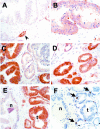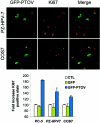PTOV-1, a novel protein overexpressed in prostate cancer, shuttles between the cytoplasm and the nucleus and promotes entry into the S phase of the cell division cycle
- PMID: 12598323
- PMCID: PMC1868092
- DOI: 10.1016/S0002-9440(10)63885-0
PTOV-1, a novel protein overexpressed in prostate cancer, shuttles between the cytoplasm and the nucleus and promotes entry into the S phase of the cell division cycle
Abstract
PTOV1 was recently identified as a novel gene and protein during a differential display screening for genes overexpressed in prostate cancer. The PTOV1 protein consists of two novel protein domains arranged in tandem, without significant similarities to known protein motifs. By immunohistochemical analysis, we have found that PTOV1 is overexpressed in 71% of 38 prostate carcinomas and in 80% of samples with prostate intraepithelial neoplasia. High levels of PTOV1 in tumors correlated significantly with proliferative index, as assessed by Ki67 immunoreactivity, and associated with a nuclear localization of the protein, suggesting a functional relationship between PTOV1 overexpression, proliferative status, and nuclear localization. In quiescent cultured prostate tumor cells, PTOV1 localized to the cytoplasm, being excluded from nuclei. After serum stimulation, PTOV1 partially translocated to the nucleus at the beginning of the S phase. At the end of mitosis, PTOV1 exited the nucleus. Transient transfection of chimeric green fluorescent protein-PTOV1 forced the entry of cells into the S phase of the cell cycle, as shown by double fluorescent imaging for green fluorescent protein and for Ki67, and also by flow cytometry. This was accompanied by greatly increased levels of cyclin D1 protein in the transfected cells. These observations suggest that overexpression of PTOV1 can contribute to the proliferative status of prostate tumor cells and thus to their biological behavior.
Figures





References
-
- Jenster G: The role of the androgen receptor in the development and progression of prostate cancer. Semin Oncol 1999, 26:407-421 - PubMed
-
- Grossmann ME, Huang H, Tindall DJ: Androgen receptor signaling in androgen-refractory prostate cancer. J Natl Cancer Inst 2001, 93:1687-1697 - PubMed
-
- Marcelli M, Ittmann M, Mariani S, Sutherland R, Nigam R, Murthy L, Zhao Y, DiConcini D, Puxeddu E, Esen A, Eastham J, Weigel NL, Lamb DJ: Androgen receptor mutations in prostate cancer. Cancer Res 2000, 60:944-949 - PubMed
-
- Linja MJ, Savinainen KJ, Saramaki OR, Tammela TL, Vessella RL, Visakorpi T: Amplification and overexpression of androgen receptor gene in hormone-refractory prostate cancer. Cancer Res 2001, 61:3550-3555 - PubMed
-
- Taplin ME, Bubley GJ, Shuster TD, Frantz ME, Spooner AE, Ogata GK, Keer HN, Balk SP: Mutation of the androgen-receptor gene in metastatic androgen-independent prostate cancer. N Engl J Med 1995, 332:1393-1398 - PubMed
Publication types
MeSH terms
Substances
LinkOut - more resources
Full Text Sources
Medical
Molecular Biology Databases
Research Materials

